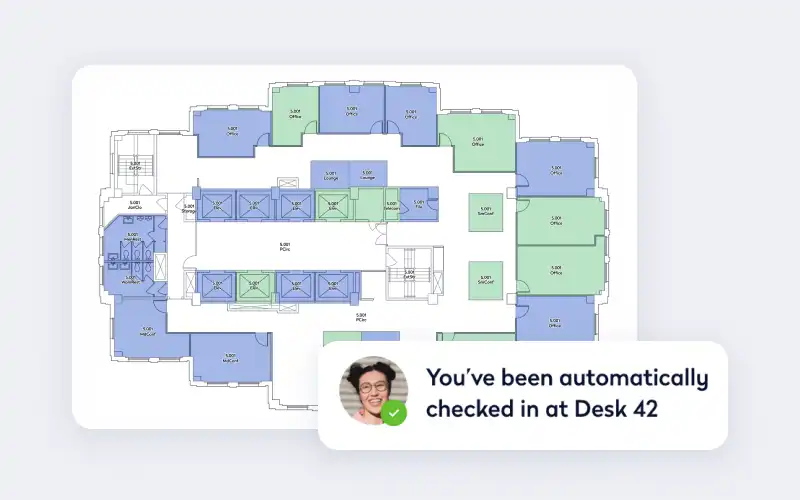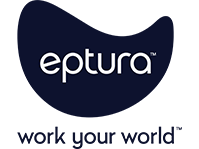
Enterprise-size organizations across industries have implemented the hybrid work model for employees, and although more people are coming into the office more often, only a few are moving back to the traditional in-office workweek. In fact, only 6% of companies surveyed said they would adopt or maintain a full-time attendance policy, according to Eptura’s 2025 Workplace Index report.
It’s just one example of how flexibility has become a key trend in facility and workplace management, reshaping how organizations operate and how employees think about work. From micro-shifts to dynamic workspaces, the concept of flexibility is being embraced in various forms to enhance employee satisfaction, productivity, and overall well-being.
Welcome to our monthly deep dive into important industry trends for workplace and facility management (FM) professionals.
What is flexibility in the workplace?
Flexibility in the workplace refers to the adaptability and freedom employees have in managing their work and personal lives. It covers a range of practices, from flexible schedules that allow workers to choose their hours, to flexible workspaces that offer the option to work remotely or in a variety of office settings. This approach not only enhances employee satisfaction and well-being but also boosts productivity and retention, making it a valuable strategy for modern organizations.
From perceived luxury to recognized benefit
The concept of flexibility in the workplace has undergone a significant transformation over the past 20 years, evolving from a niche benefit to a core component of modern work culture.
Two decades ago, organizations and employees saw flexibility as a luxury rather than a necessity. Companies might offer limited options like part-time work or occasional remote days, but these were exceptions rather than the norm. When employees thought of the workweek, it was Monday through Friday, from nine to five. Today, many consider flexibility an important part of employee well-being and job satisfaction. Many organizations now see it as a strategic advantage in attracting and retaining top talent.
New technology has been a major driver of this shift. The widespread adoption of high-speed Internet, cloud computing, and collaboration tools like Microsoft Teams has made it easier for employees to work from anywhere. Technological infrastructure has not only enabled remote work but has also facilitated flexible scheduling, allowing teams to collaborate effectively regardless of their physical location. When everyone on the team can access the same documents from anywhere, collaboration is no longer locked to specific times or locations.
Do different generations in the workplace approach flexibility differently?
Employee expectations have changed, and in today’s job market, many candidates are looking for companies that offer flexible work options. The demand has pushed some organizations to adopt more flexible policies to remain competitive.
In the episode “’Flexibility is the Future of Work’ – Strategies for Business Success, Workforce Management, and Building Productive Teams,” Silvija Martincevic, CEO of Deputy, a global workforce management platform, explains how a younger generation is updating the definition of a workday.
From 9-5 to micro-shifts
“Gen Z today makes up 51.5% of the hourly workforce. For the first time in 2025, they’re now the majority of the workforce. If you want to innovate in the workplace, you need to ask yourself, ‘What does this newer generation want? What do they want out of work and how do they approach work?’”
According to Martincevic, a traditional workday doesn’t appeal to Gen Z. Instead, they’re looking for flexibility and want more control over their personal and professional lives.
Micro-shifts are a more flexible and dynamic approach to work scheduling. Instead of following a fixed, daily block of hours, micro-shifts allow employees to work in shorter, more frequent intervals, which can range from a few minutes to a few hours, and they can be scheduled at various times throughout the day or week. The key idea behind micro-shifts is to align work hours more closely with individual productivity peaks and personal commitments, thereby enhancing efficiency and work-life balance.
For example, during an average 9-to-5 day, an employee might struggle to maintain high levels of productivity. They might find themselves more alert and focused in the morning but less so in the afternoon. In a micro-shift model, the same employee could work a few intense hours in the morning, take a break, and then work a few more hours in the evening when they feel more energized.
Micro-shifts can be particularly beneficial for those with non-traditional responsibilities or lifestyles. Parents, for instance, might find it easier to manage childcare and work by scheduling micro-shifts around their children’s school hours.
“We are seeing that they want micro-shifts that effectively help them get flexibility so they can take care of their kids, so they can take care of their parents. And 9 to 5 is just not working anymore,” Martincevic says.
How can companies create flexible workspaces?
Flexible workspaces are physical environments that can accommodate a variety of work styles and schedules. They’re popular with freelancers, startups, remote workers, and even large corporations looking to provide their employees with more dynamic and collaborative settings.
These workplaces can include:
- Co-working spaces: Shared offices where multiple individuals or companies rent desk space, meeting rooms, and other amenities. Co-working spaces often foster a community atmosphere, encouraging networking and collaboration among diverse professionals
- Hot desking areas: A system where employees do not have a fixed desk but can choose a different workspace each day. This can help optimize space and promote a more fluid work environment
- Private offices: Small, private rooms that can be rented by individuals or small teams. These offer a more secluded and focused environment
- Meeting rooms and conference rooms: Available for booking, these spaces are designed for group meetings, presentations, and collaborative sessions
In the episode “’Evolution in the World of Work’ – Strategies and Operations for Dynamic Workspaces,” Adam Stoltz, corporate real estate and workplace leader, says companies that want flexible spaces need to plan for adaptability.
“Our offices have an opportunity to be much more dynamic and responsive and perhaps even a bit bespoke to what the needs of the day or that team or even that individual could be,” Stoltz says.
He also encourages companies to think about how they can make their spaces reconfigurable. Flexibility is a cross-team project.
“We need better partnership with our technology teams so that the technology set up in the room can come together and break down and come together again in a way that, frankly, trenching in concrete and wires may not necessarily allow,” Stoltz says.
What are the connections between empathy and flexibility in the workplace?
Creating flexible spaces requires cross-team planning and the implementation of modern worktech to support desk and room booking. There are changes and updates companies must make to their facilities and IT.

For many organizations, adding more flexibility could also mean rethinking how they manage employees. Empathy and creating a flexible workplace are deeply interconnected, as both require understanding and responding to the needs and experiences of employees.
Understanding individual needs
Empathy involves the ability to understand and share the feelings of others. In a workplace context, this means recognizing that each employee has unique personal and professional circumstances. For example, a single parent might need more flexible hours to manage childcare, while a team member with a long commute might benefit from the option to sometimes work remotely. By empathizing with these individual needs, employers can design policies and practices that truly support their workforce.
Martincevic explains: “Understanding and empathizing with the needs of frontline workers and recognizing their contributions through effective communication and feedback tools, is also crucial.”
Building trust
A flexible workplace thrives on trust. Employees need to trust that their managers will support their work-life balance, and managers need to trust that employees will remain productive and meet their goals. Empathy helps build this trust by showing that the organization values its employees as individuals and is committed to their success and happiness. When employees feel trusted and supported, they are more likely to be engaged and committed to their work.
How can companies support “empathy-powered” leadership?
Companies need to recognize that not everyone can be a compassionate leader, says Jess Baker, chartered psychologist, associate fellow of the British Psychological Society.
“A person must choose to be compassionate. That person has to say, I want to be able to help others better. And honestly, not very many people say that,” she explains in episode “’Ask More Questions’ – The Empathy-Powered Leadership Journey in the Workplace.”
So, organizations should identify and nurture empathic individuals who already exist within their ranks.
Her advice: “… if you have a closer look at your internal infrastructure, if you have a look at all the people working in your organization, you’ve probably got empathic people in your organization who haven’t yet made it to a leadership role. You have the capacity to have more compassionate leadership, but you don’t have to train everyone. What you need to do is find empathic people in your organization who aren’t yet in leadership roles.”
For those hoping to add more empathy to their own leadership style, she says it’s important to go beyond simple questions. “I wouldn’t just take the first answer as their real answer, because often we don’t know what we really want. We don’t know what really would serve us. And often our first answer isn’t the honest truth,” she says. Instead, empathetic leaders keep digging deeper, asking, “Why is that?” and “Why do you think that is?”
Stay on top of the trends in intelligent worktech and facility management
Workplace and facility management are constantly evolving with new technologies, regulations, and best practices. Industry professionals always have something new to learn.
For more videos, podcasts, and webinars to keep you updated on the latest trends, visit Eptura’s resource page.









